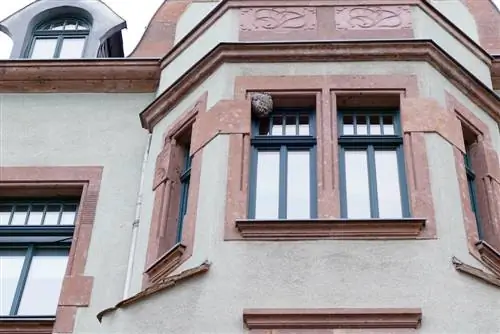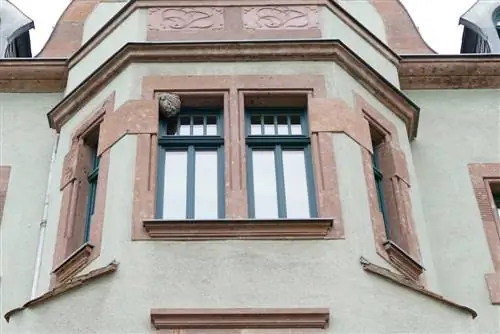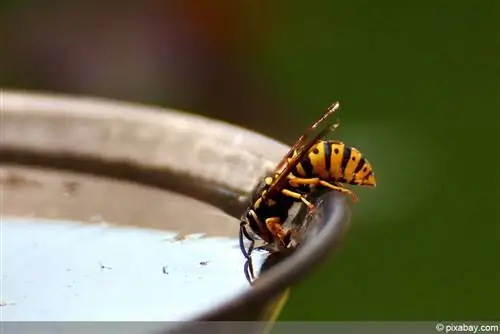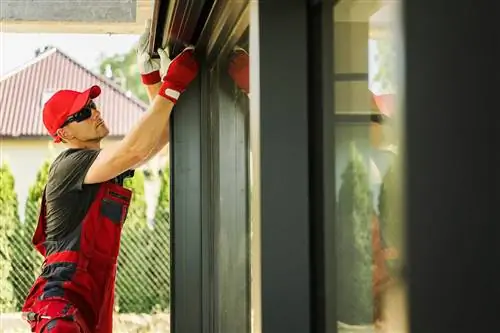- Author admin [email protected].
- Public 2023-12-17 03:39.
- Last modified 2025-06-01 06:48.
It is not uncommon for wasps to nest in and around the house, such as in the cladding of the roof overhang or in roller shutter boxes. So-called short-headed wasps, which also include the common wasp and the German wasp, nest here most often. Both wasp species vehemently defend their territory in the immediate nesting area. An existing nest can appear threatening, which makes the desire to remove it as quickly as possible understandable. However, this is only permitted under certain conditions.
Legal situation
Wasps are useful inhabitants of the earth and are rightly protected. As a result, the removal and killing of these animals is fundamentally prohibited under the Federal Nature Conservation Act. However, it can be justified in exceptional cases. This is the case, for example, if:
- Allergy sufferers or people with suspected allergies living in the household
- Do small children or older people regularly stay near the nest
- Wasps get inside the house or apartment despite protective measures
- Or the nest is located in a frequently frequented area
Removal by hand is problematic
Removing a wasp nest yourself is generally not recommended. Especially in summer and if the blind box can only be opened inwards, which is often the case. Otherwise it can happen that the wasps penetrate into the interior of the apartment and, if they feel threatened, attack. In addition, it is often difficult to estimate how large the nest actually is because often only a small part is visible.
Before exposing yourself and your family to such dangers, you should remember that wasps only live for one summer. The nests of the common and German wasps are sometimes active until November. Afterwards, first the old queen and finally the wasp colony gradually dies off, so that it is completely uninhabited in winter and will not be populated again. If you can somehow come to terms with the animals until winter, then is the best time to remove them yourself and, above all, safely, even without an exterminator or pest controller.

To do this, open the roller shutter box and first roughly remove the nest. The smaller residues can be easily removed with a vacuum cleaner. The entire area must then be thoroughly cleaned. If you don't do this, it is very likely that wasps will nest again in the immediate vicinity of the old nest. If you don't want to wait until winter and are exposed to an immediate threat from wasps, retailers offer preparations such as wasp foam or wasp spray to combat them.
Use of wasp foam and wasp spray
Wasp foam, like wasp spray, is used to kill the animals within a very short time. They become trapped in their nest where they eventually die. According to the manufacturer, the wasp foam should be used either early in the morning or in the evening. Then all the wasps are usually in the nest and it is cooler, so they are calmer and less aggressive.
- Nests in the roller shutter box can only be reached via small openings
- Accordingly, spray the foam into the entry area using a small tube
- You spray for about 5 seconds or until the escape route is completely closed
- While doing this, keep a distance of at least 2 m from the nest
- Wasp foam contains insecticides that quickly weaken and kill the animals
- After a while it collapses
- The effect of the insecticides lasts for a while
- This means that wasps that arrive later can still be reached
- Wait at least one day after application
- It must be ensured that the nest is completely calm
- Only then open the box and remove and dispose of the nest
You should avoid using a wasp spray, especially indoors. Not only do the wasps die in a very painful way, with the slightest mistake it can happen that the entire swarm of wasps pounces on the attacker. This can be life-threatening, and not just for allergy sufferers. In addition, the use of such preparations poses dangers for residents, pets and other beneficial insects that should not be underestimated, even with minor contact.
Tip:
To protect yourself from all eventualities, you should always wear suitable protective clothing, consisting of gloves, safety glasses and long-sleeved clothing.
Removal by a specialist
There is no question that it is always better to have wasp nests removed by a professional, especially in the summer months when these animals are particularly active. Only they have the necessary knowledge and equipment to be able to safely and safely remove a wasp nest and, if necessary, relocate it. In addition to exterminators and pest controllers, nature conservation authorities and, in some cases, the local fire department are also qualified to do this.
The specialist first gets an overview of the situation and then decides how to proceed. If the conditions are met, he can remove the nest. He usually does this by first picking up the swarming workers using a suction device and passing them on to an external container. The whole thing can take around 30 minutes. The nest and the queen are then carefully removed, packed accordingly and placed back later at a distance of at least four kilometers.
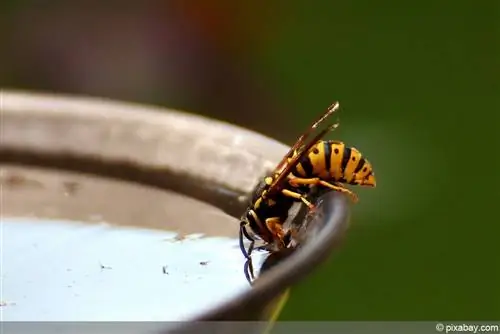
Since the space in a roller shutter box is very limited compared to the attic or roof overhang, it may happen that even a specialist cannot remove the nest without destroying it. If this is the case, killing the animals is usually unavoidable. Even the professional only kills the wasps if the nest has to be removed for good reasons and this is not possible without killing them.
Self-help until removal by a specialist
Since it may take some time until the professional can remove the nest, you should use the time until then and take precautions to ensure that no wasps can get into the living area. First of all, it is important to never close the entry holes, because wasps will always look for another way out and find it.
It is also advisable to close all openings that lead into the interior of the apartment, such as:B. at the belt exit, to be closed with adhesive tape. Installing a fly screen indoors can also prevent wasps from getting into the home. Various smells can help keep the animals outside. These can be small pots of basil, a bowl with essential oils such as tea tree and clove oil or citronella, but also orange and lemon slices studded with cloves.
Prevent nest building in the roller shutter box
Prevention is the best protection here too. There are numerous ways to prevent wasps from nesting in the roller shutter box. From March/April onwards, wasp queens wake up from hibernation and are looking for a suitable place to build their nest.
- Close all possible cavities before the wasp season begins
- Seal every gap and opening through which a wasp could get into the box
- Be alert and watch out for flight activity from March/April
- Especially now check the blind box regularly for possible nest building activities
- Move the roller shutter up and down several times a day
- Queen is disturbed by the noise and may look for a new nesting place
- Trade offers a wide variety of sealing options
- Including profile rubber seals or brush strips
- The dense bristles of the brush strips prevent wasps from entering
- To make nest building more difficult, deprive the animals of building material
- Wasps do not get their building material from just one source
- Therefore, do not leave insulation materials, rotten wood and the like lying around
A single larger wasp that can be seen in the immediate vicinity of the roller shutter about half an hour can be an indication that it is a queen wasp that is about to build a nest. On the other hand, if there are a lot of small wasps buzzing around, there is a high probability that a small nest already exists. Sealing no longer works. In both cases, you should consult a specialist as quickly as possible. At an early stage, it is usually relatively easy for a professional to remove or relocate the nest. The larger the nest becomes, the more difficult, time-consuming and expensive it is to remove.
Tip:
In the pharmacy you can have a mixture made of 1 part of an essential oil and 10 parts of alcohol and spray the blind box with it using a spray bottle. This is also supposed to drive away wasps or keep them away.
Why wasps nest in the roller box
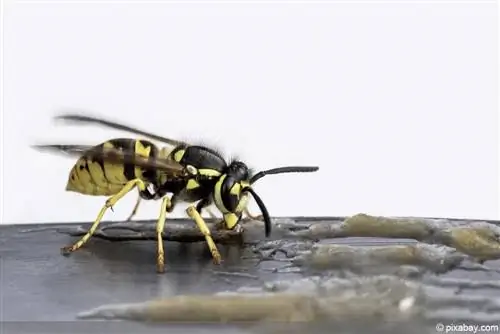
In the wild, wasps are finding suitable nesting places less and less often, so they increasingly look for them in inhabited areas. A blind box represents the optimal environment for building a nest. It is protected from wind and weather and offers ideal access. There is enough space in a roller shutter box to easily accommodate honeycomb constructions comprising several floors. In addition, the adjacent living spaces provide sufficient waste heat so that the animals are pleasantly warm at all times and can be active until autumn.
Determine wasp species based on the nest
There are 82 species of wasps across Germany. But only two cause problems: the German wasp and the common or common wasp. Both species belong to the so-called dark cave nesters, which build their nests in dark cavities such as in a blind box, under a roof overhang or in old mouse burrows. The respective wasp species can be easily identified based on the nest.
German wasp nests are rarely free and hanging open. They are gray, have a shell-like surface, with air pockets that open at the bottom. They consist of 5-10 honeycomb levels and several 1-2 cm entry openings. The dwellings, which are up to 2 m in size, can accommodate between 1,000 and 10,000 animals.
The common wasp is the most common in this country. It also prefers dark nesting places, although its nests, like those of the German wasp, are rarely free-hanging. The nest color is beige or ocher to light brown, with a shell-like structure. The number of honeycomb levels and entry openings corresponds to those of the German wasp. However, only 500 - 7,000 animals live here.
Conclusion
Wasps take on important tasks in our ecosystem. They are perfect pest controllers, take part in pollination and are rightly called the 'he alth police'. However, the common wasp and the German wasp in particular can cause problems if they choose to shelter in and around the house. Removing a nest from the blind box is sometimes difficult and not entirely safe. For this reason, it generally makes sense to contact an exterminator, pest controller or the nature conservation authority in this regard. Only they have the means and options to eliminate a wasp nest safely and safely.

